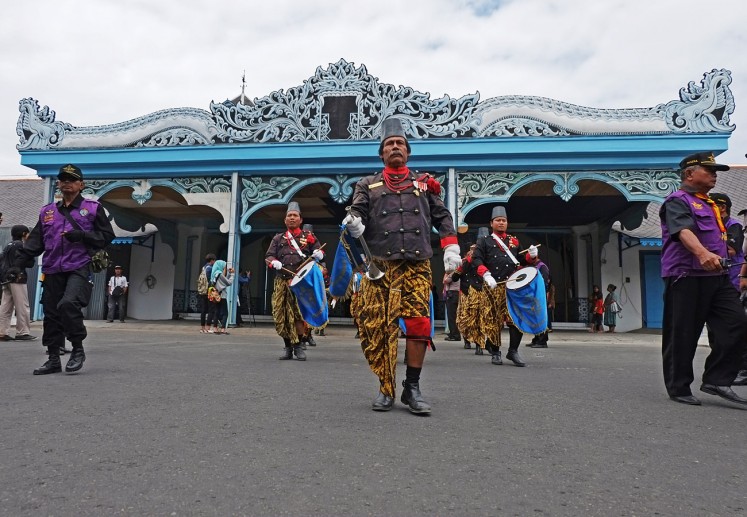Fusion food: A new wave of culinary sensations
A palatable innovation in culinary history that marries the best of both worlds ABurger King Double Black Pepper Burger or a Prosperity Burger from McDonaldâs probably do not sound too strange to you
Change text size
Gift Premium Articles
to Anyone

A
palatable innovation in culinary history that marries the best of both worlds
ABurger King Double Black Pepper Burger or a Prosperity Burger from McDonald's probably do not sound too strange to you. Perhaps you have tried one or the other during the Lunar New Year celebrations, with their adaptation of a tried-and-true American favorite with flavors reminiscent of XO Beef Black Pepper, a famous Chinese dish.
We live in a shrinking world, including our tastebuds. Today, we pick and choose from a global culinary smorgasbord, eating a variety of food almost unknown to our parents' generation. Indian food is the de facto national dish of the UK today, and here in Jakarta and other major cities pizza and other western dishes are commonplace.
It's inevitable that mixing and matching of the foods occurs, including in the special burger varieties above. Fusion food developed from the so-called pop culture of experimentation and breaking down of rigid lifestyle practices, something that came into being in the 1970s. According to its concept, fusion food combines ingredients and cooking methods of two or more regions.
Later, the fusion concept gave birth to more innovations at a number of contemporary restaurants. With time, in an industry always hungry for new ideas, fusion food has become trendy in the food and beverage (F&B) world.
Today, fusion food is popular because it offers culinary adventures based on unique and distinctive tastes, bringing more color to mainstream culinary culture.
Styles of fusion
David Farbacher, a fusion food examiner from Pittsburgh, US, points to three main types of culinary fusion. First is a combining of one particular food from one region with the style from another region. One example is Chinese cuisine enhanced with a touch of Japanese or Korean style.
Second is mixing two different styles of cuisine to create a new version of a dish. This type of culinary fusion has set the trend in the F&B scene in Jakarta and other big cities in Indonesia.
Suntiang Restaurant in Pondok Indah Mall, South Jakarta, is one of a number of F&B establishments in Jakarta featuring fusion menus. The restaurant serves authentic West Sumatran food but with a Japanese cooking style. The result is a new eclectic food style.
The menu is a brave innovation from chef Abadi Lutfi, who fuses an assortment of traditional West Sumatran recipes with his more than 20 years of experience in Japanese cuisine.
Also known as Padangnese food, the West Sumatran dishes are renowned for their hot and spicy flavors. And Abadi uniquely blends this traditional cuisine with the distinctive taste of Japanese to create unique culinary offerings.
Among the recommended dishes are edamame balado, beef rind miso soup, rendang roll, gulai ramen, rendang tamago bowl, sizzling beef tongue with green chili and asam pade sauce, and laman katan sarikayo.
A third type of culinary fusion is blending cuisine and culture into one pot. This kind of fusion is often found in countries with large numbers of immigrants, such as the US.
Examples include California pizzas that incorporate Italian crusts with a California cooking style, and Tex-Mex or Texas-Mexican cuisine.
Tex-Mex is quite popular among locals and expatriates living in the state of Texas. Historically, the food evolved over hundreds of years and was influenced by Mexican and American locals.
The food is characterized by heavy use of cheese, meat, beans, Mexican tortillas or fajitas, and Texas-style chili.
In Jakarta, you can visit Amigos Restaurant either in Kemang, South Jakarta, or Mega Kuningan, Central Jakarta, to enjoy some tasty Tex-Mex.
Peranakan cuisine
Before the term 'fusion' was known, Peranakan cuisine, which blends Malay and Chinese cooking, had already spread across the archipelago.
Peranakan cuisine is considered fusion food to some. However, others see it as local food due to its history, in which both cultures have been blended for centuries.
Peranakan itself is a term referring to descendants of the 15th through 17th century Chinese immigrants in Indonesia and Malaysia.
The food is a blend of Chinese ingredients with various spices and cooking techniques used by the native Malay community. One example of Peranakan cuisine is laksa, a spicy noodle soup, which is popular in Indonesia, Singapore and Malaysia. Laksa's thick coconut soup, which has a reddish color, produces a tangy and delicious flavor.
Dapur Babah and Kedai Tiga Nyonya are among the restaurants serving Peranakan food in Jakarta.
If in the Sudirman business district, Kembang Goela offers not only Peranakan cuisine, but also Rijstaffel food, the Dutch colonial 'rice table' of Indonesian dishes. (Andreas Setiadi Sanusi)









